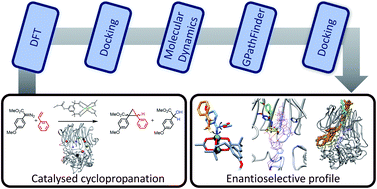Successes and challenges in multiscale modelling of artificial metalloenzymes: the case study of POP-Rh2 cyclopropanase†
Abstract
Molecular modelling applications in metalloenzyme design are still scarce due to a series of challenges. On top of that, the simulations of metal-mediated binding and the identification of catalytic competent geometries require both large conformational exploration and simulation of fine electronic properties. Here, we demonstrate how the incorporation of new tools in multiscale strategies, namely substrate diffusion exploration, allows taking a step further. As a showcase, the enantioselective profiles of the most outstanding variants of an artificial Rh2-based cyclopropanase (GSH, HFF and RFY) developed by Lewis and co-workers (Nat. Commun., 2015, 6, 7789 and Nat. Chem., 2018, 10, 318–324) have been rationalized. DFT calculations on the free-cofactor-mediated process identify the carbene insertion and the cyclopropanoid formation as crucial events, the latter being the enantiodetermining step, which displays up to 8 competitive orientations easily altered by the protein environment. The key intermediates of the reaction were docked into the protein scaffold showing that some mutated residues have direct interaction with the cofactor and/or the co-substrate. These interactions take the form of a direct coordination of Rh in GSH and HFF and a strong hydrophobic patch with the carbene moiety in RFY. Posterior molecular dynamics sustain that the cofactor induces global re-arrangements of the protein. Finally, massive exploration of substrate diffusion, based on the GPathFinder approach, defines this event as the origin of the enantioselectivity in GSH and RFY. For HFF, fine molecular dockings suggest that it is likely related to local interactions upon diffusion. This work shows how modelling of long-range mutations on the catalytic profiles of metalloenzymes may be unavoidable and software simulating substrate diffusion should be applied.

- This article is part of the themed collection: Natural and artificial metalloenzymes


 Please wait while we load your content...
Please wait while we load your content...